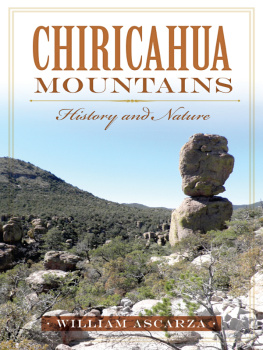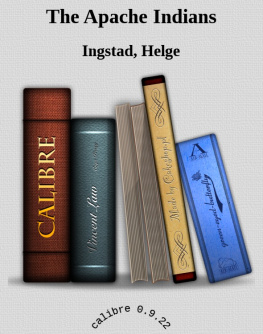This edition is published by BORODINO BOOKS www.pp-publishing.com
To join our mailing list for new titles or for issues with our books borodinobooks@gmail.com
Or on Facebook
Text originally published in 1942 under the same title.
Borodino Books 2017, all rights reserved. No part of this publication may be reproduced, stored in a retrieval system or transmitted by any means, electrical, mechanical or otherwise without the written permission of the copyright holder.
Publishers Note
Although in most cases we have retained the Authors original spelling and grammar to authentically reproduce the work of the Author and the original intent of such material, some additional notes and clarifications have been added for the modern readers benefit.
We have also made every effort to include all maps and illustrations of the original edition the limitations of formatting do not allow of including larger maps, we will upload as many of these maps as possible.
MYTHS AND TALES OF THE CHIRICAHUA APACHE INDIANS
BY
MORRIS EDWARD OPLER
With an Appendix of Apache and Navaho Comparative References
BY
DAVID FRENCH
PREFACE
THE APPEARANCE of this volume marks the publication of the third of four collections of mythology growing out of my anthropological field work among as many Apache tribes. Myths and Tales of the Jicarilla Apache Indians {1} and Myths and Legends of the Lipan Apache Indians {2} have preceded it. Enough mythology of Apachean-speaking peoples has now been published or is available in manuscript form to make comparative treatment feasible. Accordingly, in the useful and scholarly appendix which he has been good enough to add to this book, Mr. David French has brought together references to show the distribution among the various Apache tribes and the Navaho of the myths and tales found in this collection. His work opens the way for a comparison of Apachean mythology with that of other peoples of the region, and, with other types of data, should prove useful in charting the intertribal cultural adhesions of the area.
The materials which have been collated and annotated here were gathered during three field trips in the years 193135. My first contact with the Chiricahua Apache came when I was a Fellow of the Laboratory of Anthropology of Santa Fe during a summer field party directed by Dr. Ruth Benedict. My fellow students of the expedition, Dr. Regina Flannery, Mr. Paul Frank, Dr. John P. Gillin, Dr. Jules Henry, and Dr. Sol Tax, have kindly put the results of their investigations at my disposal, and their excellent comparative material has made the task of preparing this volume much easier. While I have tried to use, wherever possible, tales that I myself have collected, the myths obtained by other members of the party (particularly Dr. Flannery and Dr. Henry) have been of signal value in recovering additional material, in providing research leads, in establishing variation within patterns, and in adding to the comparative notes with which these tales are annotated. And despite a longer stay and the opportunity for intensive research, there are tales obtained by others which I did not succeed in duplicatingfor instance, V, D, 1 recorded by Dr. Jules Henry.
Besides the Laboratory of Anthropology and the members of its field party, thanks are due the Council for Research in the Social Sciences of Columbia University, the National Research Council, the Social Science Research Council, the Southwest Society, and the Social Science Research Committee and the Department of Anthropology of the University of Chicago for fellowships, grants, and financial support during the period of research. To Dr. Ruth Benedict and Dr. Elsie Clews Parsons, whose encouragement from the time of field work through the period of writing has been continuous, I am especially grateful. Dr. Parsons generosity has made possible the publication of this volume. Dr. Harry Hoijer has given me the benefit of his broad knowledge of the Apachean languages on many occasions during the preparation of the manuscript. For assistance in preparing these tales for publication, I am indebted to my wife, Catherine Hawkins Opler.
The myths were recorded from Duncan Balachu, Charles Martine, Paul Gedelkon, Leon Perico, Chatto, Samuel E. Kenoi, and Daniel Nicholas. It is saddening to realize that several of these men have since died. The last named, the youngest of the group, functioned primarily as interpreter when work proceeded with older non-English-speaking informants. Variants, summarized in the footnotes but not given in full, were obtained from a number of other Chiricahua. To all these Apache friends who assisted so cheerfully, patiently, and intelligently, I am exceedingly grateful.
Following the Indian War of 1886, the entire Chiricahua tribe was removed from Arizona (where previous efforts had been made to concentrate it) and transported to Florida. Later a home for these Apache was sought in Alabama, and finally they were brought to Fort Sill, Oklahoma, to round out a term of twenty-seven years as prisoners of war. In 1913 they were released and given the choice of taking up residence on the Mescalero Indian Reservation in New Mexico or of accepting allotments of land in Oklahoma. Approximately one hundred individuals remained in Oklahoma; the larger group journeyed to Mescalero. The myths and tales which are included here were gathered at Mescalero. It has been possible to establish, however, that the late division of the tribe has not resulted in any divergence in mythology, for both Dr. Harry Hoijer and I have worked with Chiricahua visitors to Mescalero from Oklahoma, and I have had the opportunity to consult with the Chiricahua Apache in Oklahoma, and make the necessary comparisons there.
By working with representatives of each of the three bands that make up the Chiricahua tribe, it has been possible to determine that Chiricahua mythology was a unity and that band differences were registered only in regard to minor stylistic flourishes. This is what one would expect in view of the close contacts between members of different bands, and the frequency of intermarriage. Here again, as in traits of material culture, the Eastern Chiricahua show some specialization. Their tendency to substitute Jack-rabbit for other characters in trickster tales has been pointed out in footnotes. Also this band, whose members enjoyed a more peaceful and continuous contact with Mexican settlers than was true for the others, have absorbed a greater number of elements of European folklore.
The mythology reflects common usage and concept, religious and secular, at numerous points, and I have called attention to the most important of these in footnotes. Those who wish to follow the implications further may consult my Chiricahua ethnology, An Apache Life-Way {3} A close correspondence between the activities of the protagonists of the stories and the cultural round is almost predicated by the nature of Chiricahua ideology, for the birds, insects, and Coyote are thought to have been people at one time, and mankind is but following in the footsteps of those who have gone before.
For those who can recognize them, there are many hints in these pages concerning the recent history and contacts of the Chiricahua. We are dealing here with a living literature, dramatic and satisfying to its audience, capable of modification and growth in response to changing conditions.







